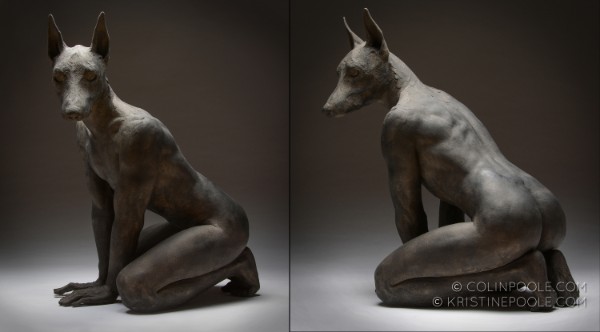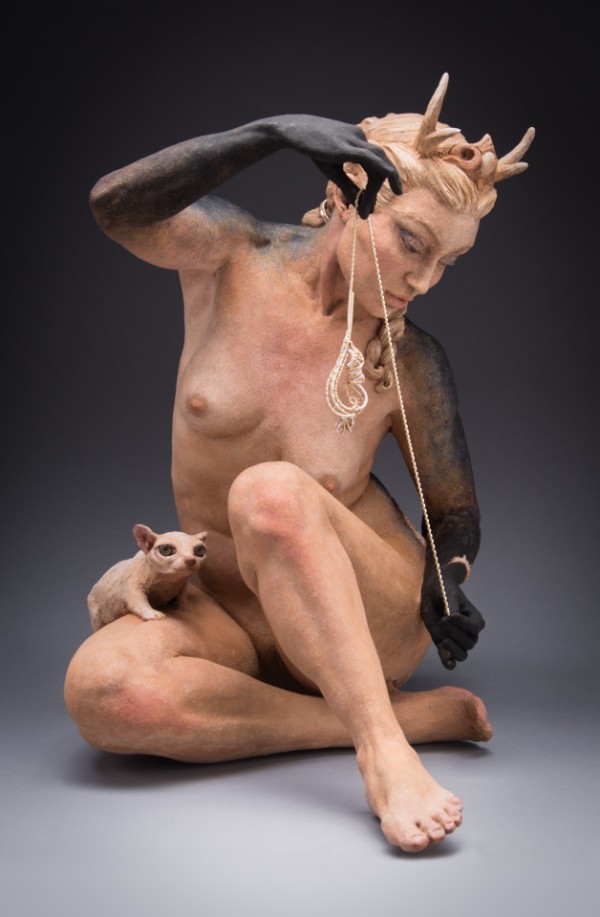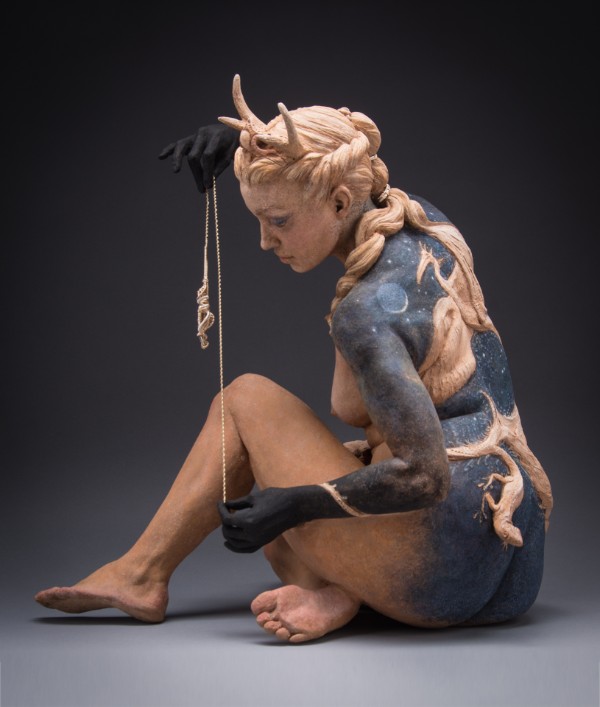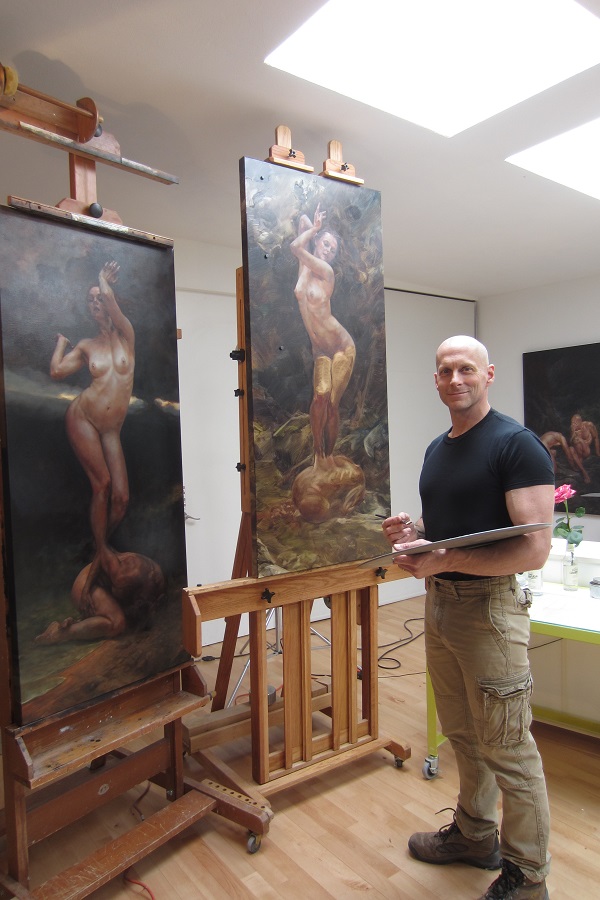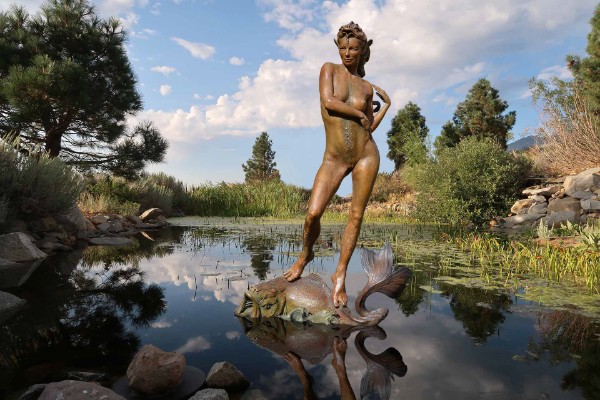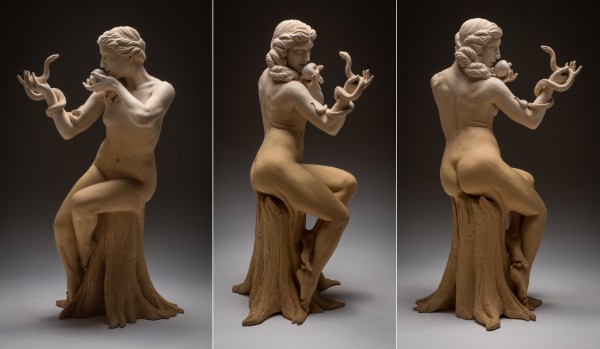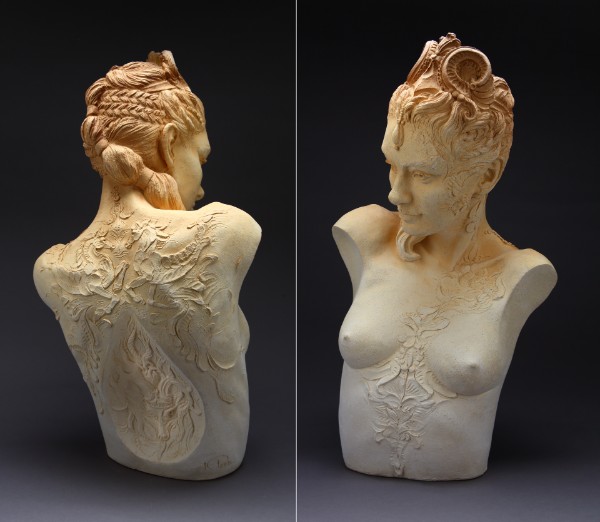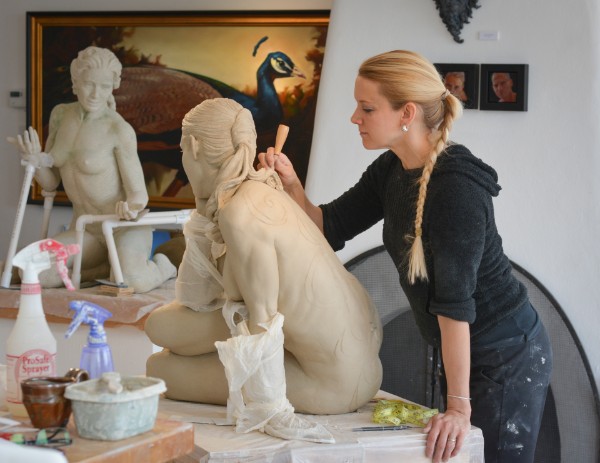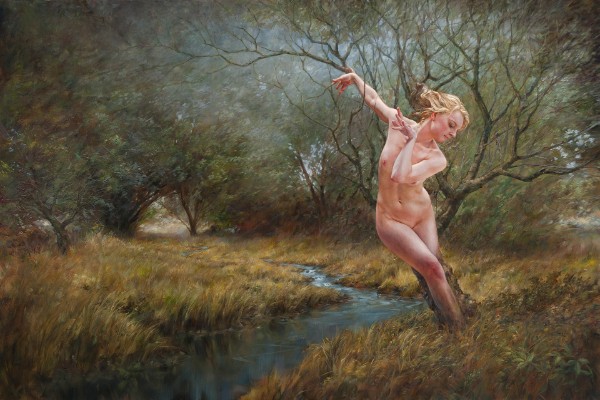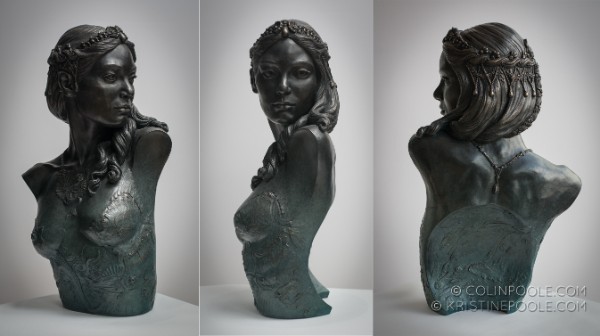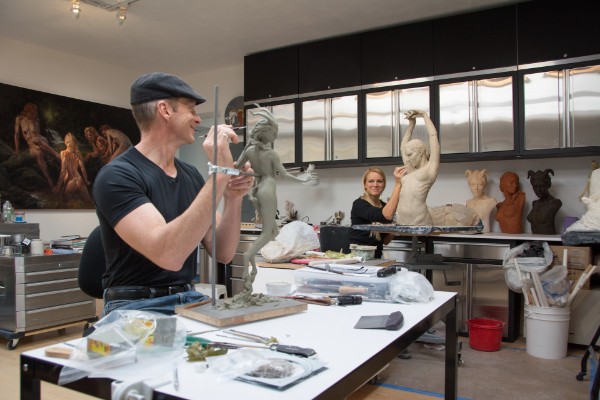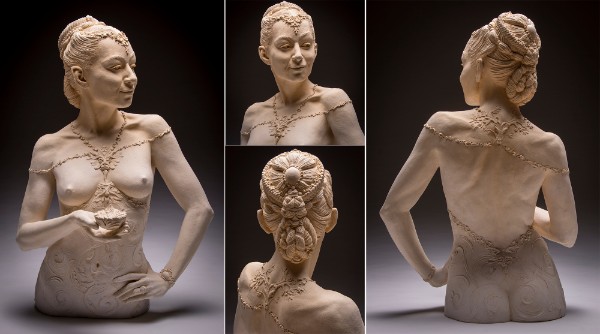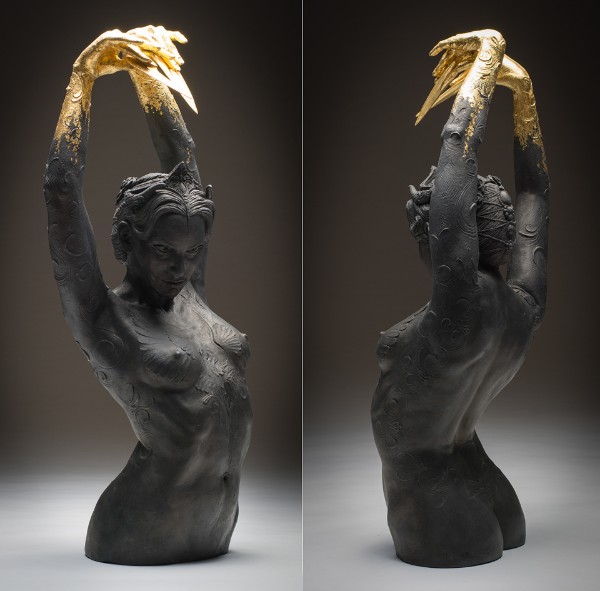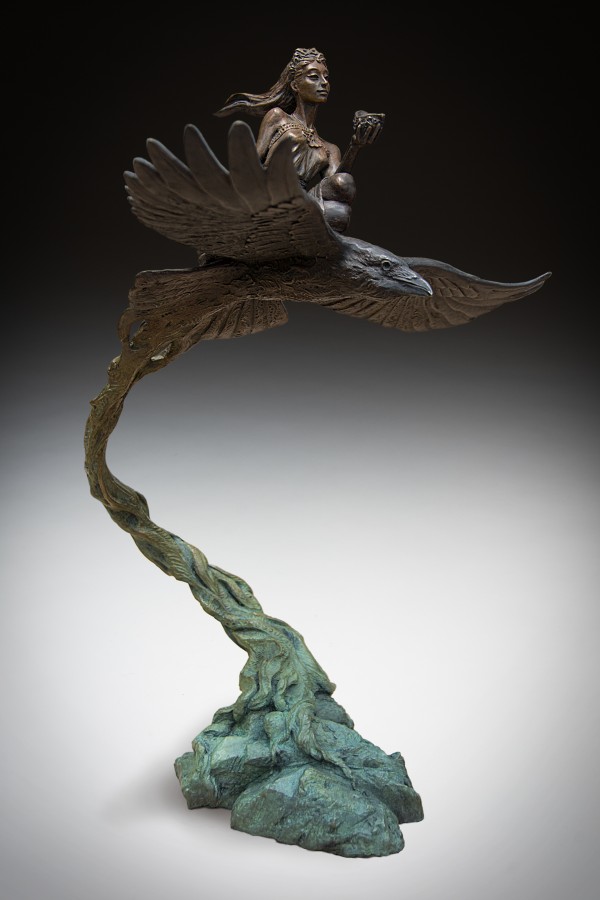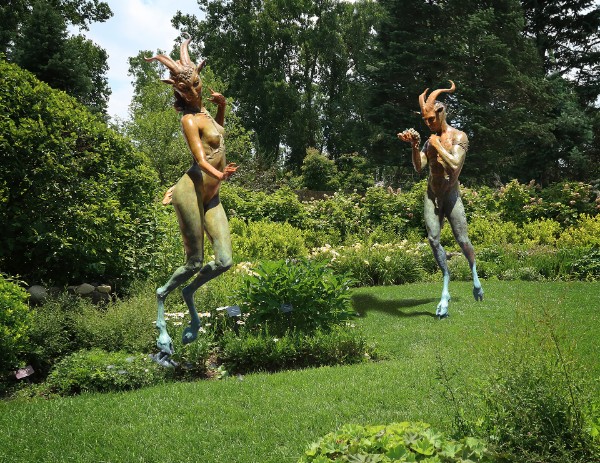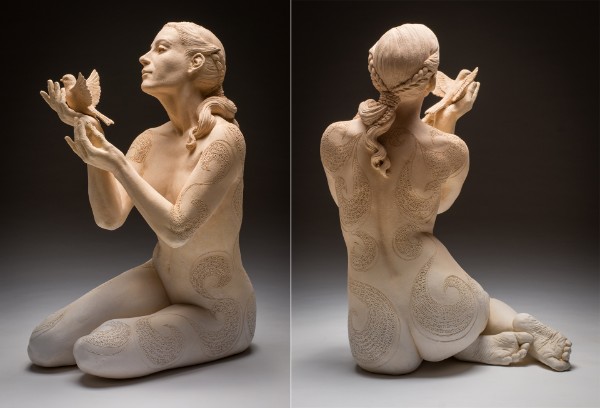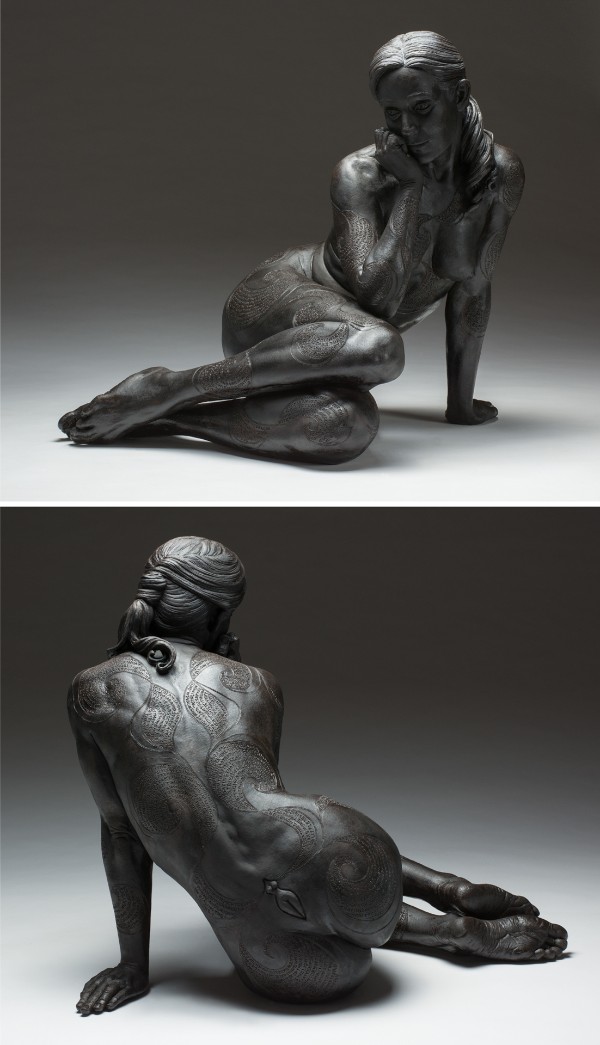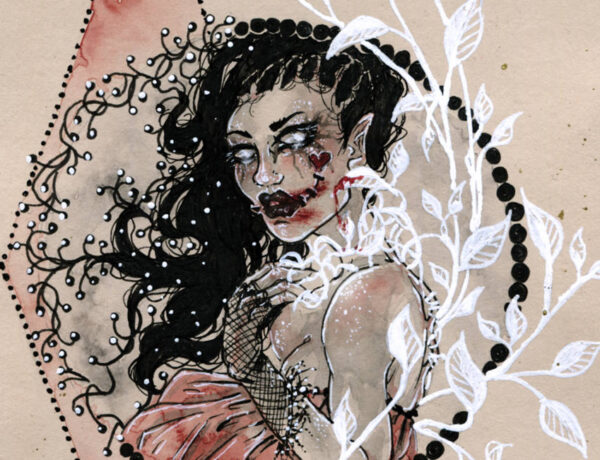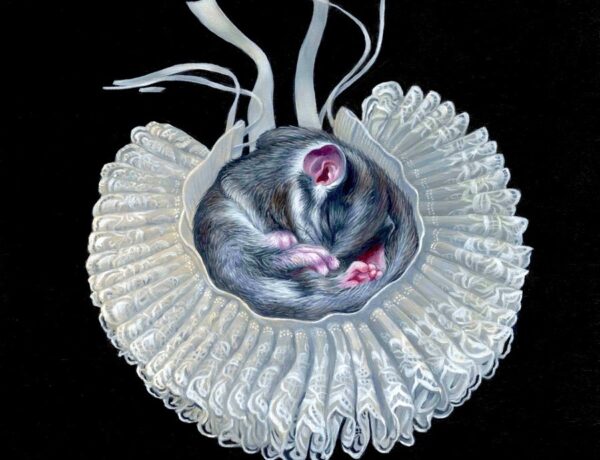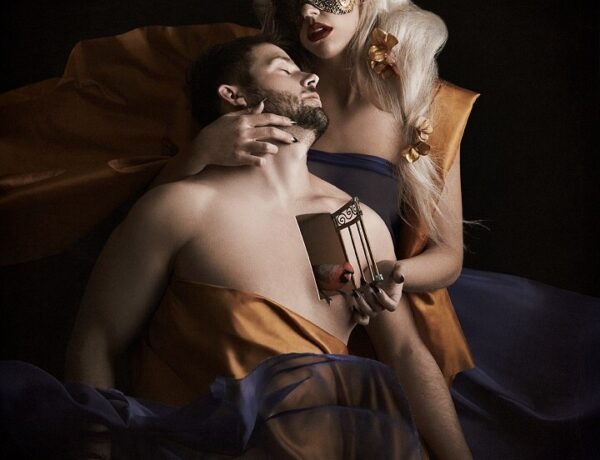When a collaboration begins with a vibrant, exuberant dance such as a tango… how can it not grow into a creative force of engaging and simply moving pieces of art. Just like the intensity of a dance, their journey into working together as artists has seen them create some beautifully elaborate and delicate sculptures. Both Colin and Kristine Poole work independently as artists, creating visually delightful paintings and sculptures.
2019 Beautiful Bizarre Art Prize entries are now open! To be in the draw to win global exposure + over US$20,000 in cash and prizes, check out the details and enter today!
Colin and Kristine recently participated in Beautiful Bizarre Magazine’s first art prize and their sculpture ‘Hot Diggety Dog’ immediately grabbed the attention of the judges. The sculpture included so many elements of the things we love here at the magazine. Having been selected as finalists, they then participated in Modern Eden Gallery’s exhibition ‘Representational’. ‘Spinner of Dreams’ was the sculpture they created and it shows the depth of talent and deeply moving thought that goes into each of their works.
The final words in the following interview, I feel, sum up this spirited and dynamic team; hardworking and willing to take on the next challenge whilst staying true to their aesthetic and independence as artists. This is something everyone can aspire to.
“Where do we go now?” I asked. “To stroll the fields of our imaginations,” he said, and off we went…
Firstly, I wanted to congratulate you on being one of Beautiful Bizarre Magazines finalists for the magazines first art prize in 2018! Your collaboration piece “Hot Diggety Dog” was incredible. We would love to share with our readers, who may be thinking of entering in the future, what the process was like for you. It was important for Danijela (Owner and EIC) to inspire creatives and to share work from those that deserve recognition and exposure. Could you tell us about the journey from the beginning to becoming a finalist and if you would encourage others to enter?
We have been huge fans of Beautiful Bizarre and the artwork they feature for years. When we heard about the Beautiful Bizarre Art Prize competition, we thought, “Oh yeah! We’d love to be a part of that.”
The entry process itself was very easy. We were impressed by the diversity of artists, work and mediums that had been submitted from around the world. Given the quality of the entries, we were delighted to learn that we’d been selected as finalists. The exposure we received from Beautiful Bizarre’s advertising and social media was incredible. The ongoing communication and opportunities for having our work highlighted has extended far beyond anything we might have hoped for. Beautiful Bizarre Magazine does a wonderful job spotlighting entries throughout the entire entry window, so be sure to get your entries in early.
After winning the art prize, you were included in the show at Modern Eden Gallery showcasing some of the finalists works. There is so much raw emotion in the piece you created for this show. It is incredibly moving, could you please tell us more about “Spinner of Dreams” and the inspiration behind it?
On the Isle de la Cite several years ago in Paris, we noticed a long line of people standing patiently in the pouring rain. We walked over and asked a couple of young women what they were waiting for. It was a concert of Pachelbel and Vivaldi at St. Chappelle. “Sounds amazing!” we said and they offered to share their umbrellas with us as we joined the line of drenched but excited concert-goers. We chatted as we waited, discovering that we shared a love of art. They mentioned a fabulous sculpture exhibit they’d just seen at the Cartier Foundation and we decided we’d go check it out the next day.
It was an exhibit of Ron Mueck. While many of the pieces were outstanding, one in particular caught our attention. From the front, we saw a young couple snuggled up next to each other. When we walked around to the back however, we saw that the boy was gripping the girl’s wrist behind her back in an aggressive and uncomfortable looking position, a gesture that completely altered our experience of the piece. We’ve talked about that work of art many times and how effectively he used the sculptural medium to play with the interpretation of story and interact with the viewer. While all sculpture needs to be seen from all sides (and many times the back is as beautiful and interesting as the front), Mr. Mueck really moved that idea into some gripping new areas.
When we were invited to participate in the Representational Modern show, we wanted to do something related to what we’d done before, but also challenge ourselves to bring something more-developing and expanding the relief work characteristic of our collaborative pieces to more fully take advantage of the three dimensional storytelling aspect of sculpture.
From the front, the “Spinner of Dreams” appears to be simply a woman spinning an elaborate and delicate object, with elements of nature woven into her headdress – small antlers and our version of an ancient triple moon symbol, hearkening to nighttime and dreams. Moving around the sculpture, hidden features emerge and the full narrative reveals itself.
Hidden behind her leg in the front view, a small bassarisk-like animal emerges on her lap, its body curving around her hip. The creature’s tail wraps into her side and then blends completely into her back, where it also becomes apparent that the more realistic coloration of the front is shifting into a full nighttime skyscape. Further around, the spinner’s hair turns into a bird that together with a lizard, emerge from and blend into her body.
Following the lines, the viewer sees that the spinner herself along with these creatures-perhaps the seemingly impossible aspects of them like the color of laughter, the feel of a bird’s song, the whisper of a cat and the warmth of a lizard – are what is being spun into the stories and dreams of our life. In many ways, she is creating herself as she spins her dreams.
Now back to earlier beginnings, can you tell us how you both started your careers? Each of you is extremely talented in your own right. The pieces you create both as individuals and as a collaboration are equally beautiful. So firstly Colin, you produce figurative, landscape and still life paintings. What were your early beginnings and inspirations for your work?
I’m a painter and sculptor, but it all began with sculpture. My mentor, hero and grandmother was the internationally renowned sculptor Una Hanbury. Many of my earliest memories are of creating in a small corner of her studio, times which she chronicled in a series of bronze sculptures of me sculpting as a child. Her encouragement and subtle guidance has had an incalculable influence on my career. In fact, the first monumental sculpture I did was a collaboration with her.
In time, I inherited both her library of art books as well as her sculpting tools. These tools leave a unique fingerprint in the clay. I love the continuity of seeing these textures reflected in my work, tying it to the textures in hers from decades before, leaving me with a distinct remembrance of her influence in my life.
I find myself immersed in inspiration everywhere all the time, from the subtle things that engage my eye in our daily adventures, like the interplay of light through the pinon branches outside our bedroom window to the frolicking rides of my imagination. Often it is the unfamiliar that most readily jumps to the forefront, but the daily experiences that we are steeped in are fertile ground for creations as well. We are also unabashed museum enthusiasts and will travel far and spend extended focused time savoring the creations from the past. The vision and technical mastery that is so often exhibited inspires and keeps the bar high for our own work.
I find myself wandering down a multitude of creative paths at the same time and it shows in the variety of my artworks. A stroll in the hinterlands is begging to be painted, the verbal description of a strawberry sent me off on a multitude of still life paintings and anything with the figure can captivate me for a lifetime. Most recently, I find a deep pleasure in combining still life, landscape and the figure. Everything I’ve explored and experienced leads me to where I am now.
I’m often asked if I prefer painting over sculpture or the reverse. It’s a curious question. When I have a brush in my hand and am immersed in a painting, it’s a delight that is hard to describe. When I am playing with clay, it’s a pleasure beyond words. If I have to choose, I choose both.
Kristine, I know you started as a dancer, can you tell us how this led into sculpture and how your career as a dancer influenced your work?
I have always been an artist. One of my earliest memories is of my mom setting me on a high chair at the counter to draw with colored pencils as she got my elder siblings ready for school. Being a creative parent, she also let me stay home from school on occasion to draw with her when she was working on commissioned projects.
I studied art through high school and ultimately received a Bachelor of Fine Art degree with a concentration in ceramic sculpture, graduating Summa Cum Laude from Northern Michigan University. During my schooling, outside of class I worked for years with a master glass blower. After university, I apprenticed with a master ceramist for a year, and then moved to New Mexico to work at Shidoni Bronze Casting Foundry.
After this move, part of my creative focus shifted to Ballroom dancing. I taught, performed and competed, formed a professional dance company and opened a studio. My forte was choreography and my palette was the body. The study of dance is a transformative experience. I learned incredible things about line, movement, rhythms, ephemerality, expression, grace, power, beauty, communication, body language and human experience through dancing. During these years, my physical artwork was on a smaller scale and centered simply on the act of creating, not marketing, sales or shows.
The shift back to full-time, large-scale sculpture occurred around 2008 (not by chance, it at the time Colin and I joined forces). At that time, I felt that the things I wanted to explore and express would be most powerfully communicated through sculpture. Elements of dance often surface in my choice of models and poses. It can also be intuited in my tendencies towards presenting women as powerful beings, comfortable in and with their bodies and in the strong use of body language in conjunction with other forms of storytelling.
I am always interested in how two artistic beings come together, especially when they are able to collaborate so effortlessly? How did the two of you meet and is it easy to work together when creating a piece?
As artists, we tend to be solitary creatures – totally engrossed in long hours of conversation with our muse rather than with other people. We’re all familiar with the days and nights spent in the studio, times in which we surface only periodically, sometimes a bit disoriented by the world outside. As such, collaborations between artists are often talked about similarly to the “Clash of the Titans.”
Colin and I have had a very different experience of collaboration, one in which we feel more like two kids building a fabulous sand castle on the beach. Our conversations tend to be of this nature: Me: “I was thinking, what if we…?” Colin: “Yeah! And then we could…!” Me: “Yes!!! And then let’s…!” And suddenly what we are creating together has blossomed into something much more expansive and expressive than what we might have done on our own.
We first met when Colin asked me to dance a Tango. I said yes. He kept asking and I kept saying yes and it all began. We married shortly thereafter. Part of what I brought to our new marriage was about 1000 pounds of clay, which Colin says was literally inspiration in a box (okay – a whole bunch of boxes!) I shared my love of fired clay sculpture with him; he shared his love of mythology with me and the result was our first collaborative series, “Chimaera.”
Colin’s sculptural style is very intuitive, frequently involving expressive tool marks, accent textures and relief embellishments. I tend to smooth the surfaces of my figures highlighting the anatomical forms and creating a responsive surface for text. We each have our own bodies of work – concepts and directions that inspire and intrigue us individually. Often times, these ideas spill over to influence our collaborations such that our multiple bodies of work might be seen as developing in a parallel vein.
We are often asked how this whole process works – do we talk about it before we start, lay down some ground rules for engagement, create a “collaboration contract” of who does what (you get to sculpt the eyelashes if I can do the earlobes)? Well, no – much as our relationship has been easy and developed organically, so has our collaborative process. We trust each other’s aesthetic sensibilities, talents, commitment, skill sets and ideas implicitly. As artists, we speak the same language whether verbal, visual or tactile. It is much like having two minds and four hands integrated in a similar vision.
Kristine and I never discussed collaborating, we just did it. Working together every day in the same studio space, being inspired by what the other is creating and our constant conversations on everything art was the natural offshoot of our love and passion. Often times in creating a sculpture, we both have our hands in every part of the process, from the initial concept, to the selection of a model and the pose, to the parts wherein we are both literally sculpting on opposite sides of the piece at the same time. Many of our collaborations are truly 50/50 in this way. On others, one of us may take the lead conceptually or physically – we consider this person “the principal” on that particular work with the other jumping in to help on smaller parts of the process.
For our Art Prize finalist piece, “Hot Diggety Dog,” as with all the sculptures in the Chimaera series, I began with the human body and Colin created the animal head. After we joined these two components, Colin worked over the whole sculpture, adding the textural details that blended the parts and created a transitional element hinting at a magical being as well as giving the impression of having been sculpted by one hand.
For sculptures that are cast in bronze, we are involved in the entire process, doing much of the refining work ourselves. We both worked in art foundries in the distant past, so are familiar with all the aspects of bronze casting. Depending on the production schedule, we often make the silicone mold and other times a professional mold maker creates the mold for us. We then pour and dress the wax, which is sent to the foundry to be cast. The bronze parts are shipped back to us and we weld them together, chase the bronzes and apply the patina. We are very particular about doing these parts of the process ourselves, so we can maintain the integrity and energy of the original in every casting.
Kristine, your sculptures seem to express a multitude of emotions. The narrative in your sculptures creates a whole story in a single unmoving object. I particularly love the EPIC series, where you layered text across the figures. Could you elaborate not only on this series, but how the ideas come to you and how you create such powerful pieces?
I find the linear nature of verbal language to be challenging in communicating complex concepts. Ideas typically come to me in the form of images-a 3D “thought block” wherein many different experiences and ideas are inextricably woven together, making it seem difficult to pull out that one thread that can communicate all the aspects of the complete thought. When I have been chewing on a particular question, word or experience, a picture will flash through my mind. The visual symbology helps me to understand the situation in an instant. Derivations of these mind pictures are the basis for much of my sculpture.
Given the challenges, I have experienced in verbal versus visual communication, it is interesting to note that I have been combining words and visual imagery for as long as I can remember. As a little kid, I did drawings of animals with words inscribed in the shapes. In high school, words would be hidden in the wood grain of floorboards in a drawing or material patterns in a still life. At university, I began writing on my sculptures to show the powerful potential words have to label, define and create realities – what other people say to us and about us can have a dramatic impact on our views and experience in life.
I came across the word “synchronic,” referring to something (usually in language) that exists at one point in time, and began considering how that word was expressed in narrative sculpture – an inherently synchronic object being used to tell a story, which is in its nature diachronic, something happening through time. Going with my own take on those two concepts, I wanted to explore the possibilities of including both in a single object.
In the EPIC series, I immersed myself in this experience of contrasting/complementary forms of narrative storytelling. Layering text on a figure creates an intriguing dichotomy. We respond instinctively and viscerally to the body language – the posture and pose in a figurative sculpture – and more intellectually and emotionally to the written word. My mind flips back and forth between the visual imagery and being engaged in what the words say. The words themselves, emphasized by the planes of the body, create a pattern and texture as unique as the cadence of someone’s speech patterns.
With EPIC, my focus was on stories we tell – words we say about ourselves, words we say to ourselves, and words other people say about us. This is reflected in several ways in the series.
I began with a more personal experience of identity – how the stories we perpetually share with others, what we view as the defining experiences of our lives, somehow describe who we are and how we see ourselves. This moves into the experience of how we read someone’s life story in their body language and how they look – how their story wraps around them, their internal landscape being reflected in their external visage. Other works bring into consideration how we can be constrained or defined by the stories people have about us – the experience of words being as powerfully binding as physical restraints.
In the same way Kristine expresses the narrative in her pieces, you too Colin, generate emotive expressive paintings. THE MYTHMAKERS: GODDESSES, GODS AND HEROES is a mind blowing series! I know you have said you wish the viewer to experience your work unencumbered by your words but are you able to also answer the same question in relation to your works and also to this particular series as best you can?
When I was five years old my grandmother introduced me to an old Greek icon painter, Christosomos Chakos, and he and I became friends for life. Christy invited me to create in his studio and while he worked on his projects and I on mine, true to his name which loosely translates to “golden-tongued” or “the storyteller,” he would regale me with animated retellings of the Greek myths. My love and exploration of mythology has lasted a lifetime and it was those stories from long ago that set the seed for much of what I do today. The majority of my work, both paintings and sculptures, have strong ties to world mythology as well as my own personal myths.
There was a time wherein I preferred my creations be viewed unencumbered by my words as I felt I could speak the visual language with more dexterity than the verbal or written. Now I find there is so much more that that I wish to express and harnessing the written word is a boon that has led me in new directions in my work.
I’m a storyteller at heart and am currently writing an original mythology that weaves my lifelong study and my imagination together. The joy of listening to the myths as a child has found new expression as I discover myself in the role of the raconteur. In truth, I still find myself in the role of the listener as well since I too, wish to hear the rest of the story even as it’s in the midst of its creation. I am also bringing these stories to life through sculpture and painting. Sometimes the words come first and then the artwork. Other times, it is the reverse. More often it is the interplay of both that brings each into being.
You both have an impressive resume, showing at many galleries around the world and many juried exhibitions. Can you share some insight and your experience on the current art climate with some who are perhaps just starting their journey?
We believe it’s never been a better time to be a professional artist. There are a plethora of avenues to unleash your creations into the world. Social media has made it possible to reach out to other artists, enthusiasts and collectors around the world. This wonderful river that we are all frolicking in, truly encircles the globe.
Some things new artists might have heard before but that bear repeating are these: find your unique voice; follow your creative obsessions; be inspired by but do not attempt to replicate those whose work you admire; try not to let the “no’s” derail you from your path-the same artwork that is rejected from one contest may well be an award winner in another; your vision and experience is unique in this world – if you don’t share it, it will never exist and we will all be the lesser for that decision.
There are many whole conversations to be had on this topic, but here are a few other thoughts:
- Begin by honing your skills-continue to learn and develop them throughout your career. Try not to presume you know everything in your medium – if you think you do, maybe it’s time to learn something new to expand your repertoire to keep your work fresh. Robert Henri said that “creativity is doing what you don’t know how to do.”
- Maintain a curiosity about everything. All manner of seemingly disparate things can inspire your work.
- Something we hear with frequency is an artist saying, “I don’t want to market myself-I just want to be in the studio.” While this is true for most of us, it’s a derailing fantasy that has no basis in how the career of an artist actually works. The reality is promotion is an integral and essential part of your art career and is an aspect of your art practice you’ll need to become proficient in. It’s not something that can be handled by someone else. If you are not a natural marketer, many of the aspects of promoting yourself and your work can set you out of your comfort zone, but with practice it gets easier and you’ll get better at it.
- Be as professional as you can be in your presentation of yourself and your work. Return communications and try to get the information people need to them as quickly as you can, but don’t let this overshadow your studio time. Sometimes you can’t do everything and sometimes you have to say “no.”
- Having many irons in the fire can help keep you on track when one opportunity falls through. On the flipside, if you’re not failing sometimes, challenge yourself more.
- Have multiple ways of generating income with your art to buffer the sometimes wildly fluctuating income of an artist. Depending on the nature of what you create, some possibilities include gallery representation, local studio tours, working commercially, selling your work online, conventions and expos, teaching workshops, crowdfunding. Approaching the business side of your work with the same level of creativity and innovation that you approach your art with can make a huge difference in your success.
- If you’ll be selling your work yourself, learn what you need to know about doing everything legally. Find out about your region’s business and tax filing requirements AND keep on top of it every year. Nothing can bog your progress down more than having to wade out of several years of back what-evers you have to contend with. Having these things unresolved saps your mental peace and creativity. Most cities have small business incubators/workshops for free or for a small fee that can teach you about good business practices and keep you out of trouble.
- Take care of yourself physically and mentally. Regulate your exercise and sleep and be mindful of what you ingest, both in your body and mind; take time to do things that rejuvenate your mind and spirit; surround yourself with positive people who support your vision; if you don’t know how to do something, ask someone for help, if you are not finding joy in what you’re doing, try heading in another direction – as “The Boss” says in “Dancing in the Dark,” you can get tired and bored with yourself and that will show in your work.
- If you’re really just beginning, start by assessing where you are and setting “specific measurable objectives.” Try to make the objectives as specific as possible, so you know where you’re headed and so you can measure whether you’re making progress in that direction. You might have heard this approach to goal setting being described as the OKR method. For more information check out this Profits blog post explaining OKRs. So, how can you put OKR into action to benefit you and your business? Don’t just say, “I want to get better.” Make a plan to draw (or sculpt, or paint) every day for x number of hours – this is a measurable goal and in doing this specific thing, you will get better. For example: 1 – Produce a series of five to ten works that relate to each other and demonstrate your unique artistic voice. Get professional quality images of them. Learn how to watermark any image you will be putting online so there is always a way to find you through your images. 2 – If you don’t have a website/social media presence, build one. 3 – Enter, with the intention of having your work accepted into x number of group shows/conventions/expos in a specific period of time to build your experience. On this one, be careful of the entry fees and shipping costs to shows that are outside of driving distance – these costs can add up quickly. 4 – Depending on the direction you want to go with your work, research and approach x number of galleries that are suitable for your work (again, this is a whole topic of conversation by itself) or x number of potential clients that are suitable for your style of work and so on. Assess, evaluate and keep setting new concrete objectives that further your progress.
- While the naysayers in our lives often offer what they consider to be sage advice, “be sure to have something to fall back on if this art thing doesn’t work out,” instead consider taking the “Alexander the Great” approach. After crossing the Dardanelles into Asia Minor with a fleet of Greeks and Macedonians in 334 BC, Alexander ordered his men to burn the ships when they reached the shore. This galvanized his troops by eliminating the option of retreat. The only path to success lay in front of them.
We always love to know more about the physical side of your work, what your day is like and how your studio space and external influences of your environment contribute to your ideas and inspiration? Could you share a typical day with us, what music is playing? What is the environment like?
Nestled in the foothills of the Sangre de Cristo mountains of Santa Fe, our studio and home originally belonged to Colin’s grandmother, renowned sculptor Una Hanbury. Managing two full-time artists with multiple bodies of work in various disciplines requires versatility, creative use of space and…lots of wheels.
Our home is a traditional adobe that we renovated to suit our “all art, all the time” sensibilities. Forgoing nonessentials like a dining room, living room and TV (artist friends who were influenced by and adopted this approach refer to it as “Going Full Poole”), we created a contemporary home that integrates indoor and outdoor spaces and features a primary studio, a gallery exhibition space, and an auxiliary studio, which has kilns and bronze finishing equipment. Given our temperate weather much of the year, projects that are particularly noxious or messy are often tackled al fresco.
The studio is flooded with natural light via skylights and window walls which open into the back gardens and aviaries (we raise exotic pigeons that often visit the studio as we sculpt). Our work spaces have abundant track lighting that is color matched to daylight, providing a smooth transition for nighttime work. The gallery has window walls everywhere which highlight our artwork against a backdrop of mountain vistas and xeric gardens.
So… wheels… we are both sculptors who work in clay and bronze and Colin is, of course, also a painter – exercising all of these disciplines provides a more diverse palette of creative options. Accommodating the workflow of two productive artists requires adaptability, consequently just about everything is on wheels. The studio, although not large, is frequently (and quickly) reconfigured to suit our current projects. Flexibility is key and everything has its place which keeps the studio fairly tidy. Even though things can get a wee bit congested, we revel in sharing the same space- constantly talking, giving input, sharing ideas and collaborating on sculptures. We adore audiobooks, podcasts and Pandora, listening to everything from Dan Carlin’s “Hardcore History” to AC/DC. Colin is a devoted lover of books and listens to them continually while he creates, having been entertained and engaged by well over 6000 audio books.
Probably the most consistent thing about our daily schedule is its variability. We are often involved in a multitude of things at the same time so the layout of the day flexes to accommodate the latest focus. We generally say yes when asked to participate, so our calendar is usually packed months in advance. Most days start at the gym around 6 AM with cardio (during which we study anatomy videos on proko.com) and weightlifting (insurance for the sculptors’ lifestyle where most things are big and heavy.) We work every day of the week with the days starting well before sunrise and running late into the night. This being said, we love we do and a day creating in the studio is a joy. We do find that tending to the many aspects of the business side can often take a healthy chunk of time out of the day. Our schedule can be intense-there are times where we work literally from 5 AM to 11 PM for weeks on end to keep projects on track. We do take occasional evenings off to spend time with friends or to rest and recharge.
Could you name some of your favourite artists (living or dead) that you both feel effected or shaped your pieces in an important way?
We are inspired by so many things, this is a difficult question. Of course, the historical European sculptors have had an enduring impact on our work. We are passionate about studying the master artworks in museums around the world and usually plan our travels around works we want to see or museums we want to visit. Carrier-Belleuse, Carpeaux, Fremier, the terracotta bozzettis, Mucha and Tiepolo are a few of our myriad historical favorites. Certain works that we visit whenever we can were pivotal for us at various times in our careers: Bernini’s “Persephone” for sheer sculptural mastery, Theodore Gechter’s “Battle of Tours” for its storytelling drama, Carrier-Belleuse’s “Mary Queen of Scots” as a clay embellishment tour de force, Giambologna’s “Rape of the Sabine Woman” for its classic spiraling format with no “flat” views, Houdon’s terracotta portrait of a young girl for his handling of the eyes, Gericault’s “Raft of the Medusa” as an emotional masterpiece, Delaroche’s “The Execution of Lady Jane Grey” as a poignant response to tragedy and most anything Singer Sargent, Bouguereau or Bernini because they are superlative.
As to contemporary art, we live in a time of inspired and inspiring artists – to select from the multitude whose work we admire would be challenging. We are grateful for the contributions of so many incredibly talented people who enrich our world. As part of our commitment to supporting contemporary art, we feel strongly about collecting pieces from artists we admire. Our collection contains varied works with the only commonality being that each spoke to us strongly. We hope that in purchasing works we love, the artists are encouraged and supported to create more.
Looking back on your journey thus far, what has been the most important lessons you have learned?
Colin: Lessons are fairly limitless from the “Wowza, who knew that would work?” to the “Whoops, l’ll take a pass on that next time”. Often the memorable lessons are personal and specific and may not translate such as “If you find a rusty nail in your French cuisine and don’t stop eating, you will be quite miserable the following day.” So instead of lessons, I will leave you with my words to live by: Revel in your obsessions; nurture ravenous curiosity; explore continually; hone your skills constantly; be passionate and delight in your imagination.
Kristine: If my first response to an idea is “it’s impossible” or “I have no idea how to make that happen,” that’s usually exactly the direction I need to go. When I definitely commit to myself and decide I’m going to make this thing work (whatever it may be), all manner of opportunities I couldn’t have imagined present themselves.
I’m happiest when I am busy. Having many irons in the fire means that if one opportunity doesn’t pan out, there are several others I can focus on to keep from getting derailed. That said, I don’t do my best creative work when I’m exhausted. Juggling business, commissions and my personal art is challenging. When the art that I’m most passionate about gets put on hold for too long, I feel lost…it’s important to maintain the balance.
I have learned that when my mind starts to go down the dark mole hole of self-doubt, it is something that will pass with time or more expediently, in the moment I allow myself to fall in love again with the next sculpture (getting busy in the studio is always a good remedy). I don’t have to waste time engaging with the hungry wolves of the mind.
What is on the horizon for both of you this coming year?
Kristine: I am preparing a new series of works for a two-person show with Francis di Fronzo that opens May 31 at EVOKE Contemporary in Santa Fe, NM.
Colin: I’ve been writing an epic mythology and rendering pivotal scenes in paintings and bronze sculptures. The myths are made of whole cloth and the frolicking of my imagination but have a cadence reminiscent of ancient storytelling. This year I will be expanding the origin myths, the ensuing stories and creating the next round of accompanying sculptures and paintings.
We will also be debuting new work throughout the year at various events including: Spectrum Fantastic Art Live in Kansas City, MO March 29 – 31, Sculpture in the Park in Loveland, CO August 9 – 11 and IlluxCon in Reading, PA October 16 – 20.
“Where do we go now?” I asked. “To stroll the fields of our imaginations,” he said, and off we went.
Follow Colin Poole and Kristine Poole here Web (Colin) (Kristine) | Instagram



